Highly Important David Drake "Silent Period" Stoneware Jar Inscribed "Mr. Miles / Dave / Aug 16 1845"
Spring 2022 Stoneware Auction
Lot #: 26
Lot #: 26
Important and Possibly Unique Three-Gallon Alkaline-Glazed Stoneware Jar, Inscribed "Mr. Miles Dave / Aug 16 : 1845," David Drake at Lewis Miles's Stony Bluff Manufactory, Horse Creek Valley, Edgefield District, SC, 1845, ovoid jar with narrow mouth, semi-rounded rim, and open-strap handle construction, the surface covered in a glossy, flowing alkaline glaze in shades of light-green to dark-olive. Shoulder incised on one side with the inscription, "Mr. Miles Dave." Three incised slash marks above denote the gallonage of the vessel. Reverse incised with the date, "Aug 16 : 1845." This jar is the only example of inscribed stoneware known from Drake's "silent period."
As detailed in Goldberg and Witkowski's seminal Ceramics in America 2006 article, "Beneath His Magic Touch: The Dated Vessels of the African-American Slave Potter Dave," no inscribed pieces by Drake were then known bearing a date between October 1843 and January 1849. During this period, he was enslaved by the Landrum family: from 1843-1847 by Reverend John Landrum and from 1847-1849 by the reverend's son, Benjamin Franklin Landrum. The reason for the absence of inscribed work from this period has been the topic of lively discussion in Southern ceramics circles for years. The predominant theory is that the Landrums forbade Drake from writing on his pieces during this time. Several years ago, long after the Goldberg/Witkowski article was written, this enigmatic jar surfaced. Bearing an inscription for Lewis Miles, Drake's previous owner and son-in-law to Reverend John Landrum, this jar survives as a curious contradiction to what was previously-accepted knowledge. The inscription on the jar suggests that John Landrum rented Drake, on at least one occasion, for use on Miles's nearby pottery. We are aware that Miles had no issues with Drake inscribing his ware; a large number of pieces made during Drake's enslavement by Miles, circa 1840-1843, include various combinations of the potter's own signature, a date, and the inscriptions, "Lm," "Mr. Miles," "L. Miles," or "Mr. L. Miles." Such writing returned to Drake's work in 1849, when he was owned once again by Miles, and continued until his emancipation in 1865. The jar's refined form is noteworthy. Its narrow mouth and open strap handles are highly unusual in Drake's decorative vocabulary. In our research, we can locate only one other documented Drake jar with the same open-handled construction, an 1858 poem jar, inscribed "I made this for our sott / it will never-never, rott," in the collection of the High Museum in Atlanta, Georgia. The glaze is highly successful as well: thick, bright, and heavily lustered. Perhaps Drake, during this brief stint with his previous owner, was tasked with producing specially-ordered pieces. Drake's mysterious tenure with Miles in August of 1845 may be explained in part by an obituary in the Aug 27, 1845 edition of the Edgefield Advertiser stating, "Died, at her residence in Russell County, Alabama, on the 12th of August. Mrs. ELIZABETH C. SWEARENGEN, consort of Mr John B. Swearengen and the daughter of the Rev. John Landrum, of Edgefield District, S.C., in 43d year of her age, leaving a bereaved husband and family, and a numerous circle of friends to bemoan their irreparable loss." Reverend Landrum's daughter, Elizabeth, had died just four days before this jar was made. Mourning his daughter's death and possibly in Alabama at the time, Landrum may have left Drake to work for Miles in his absence. This jar brings to light intriguing questions about the nature of enslaved labor in the Edgefield potting community, including Drake's mobility as an artisan and the demand for potters at his level of training. Combining form, glaze, and a highly-important date, this jar survives as one of the most outstanding works by David Drake to come to auction in years--a pot that tells a story still waiting to be fully unearthed. Provenance: Descended in the family of a Georgia consignor. Missing one handle. Some wear to remaining handle. A 4 1/4" loss to rim. A 4" surface line to top of rim. Significant cracks at base and underside suggest the jar's base was reglued. A few of these cracks continue partway up body of jar. H 14 1/4".
A Few of the Related Items We've Sold

Exceptional Edgefield District, SC Stoneware Face Cup

Important Double-Handled Stoneware Jug by Dave (August 31, 1852), Edgefield District, SC

Important Stoneware Jug by Dave (August 17, 1852), Edgefield District, SC
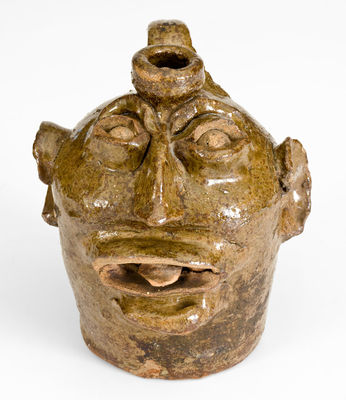
Exceptional Edgefield District, SC Stoneware Face Jug, Lewis Miles' Stony Bluff Manufactory
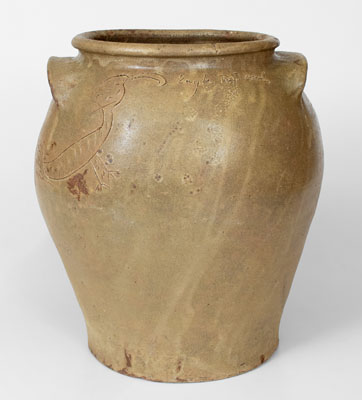
David Drake's "Eagle toed owl" Jar, Exceedingly Rare and Important New Discovery, Edgefield District, SC, c1830-40
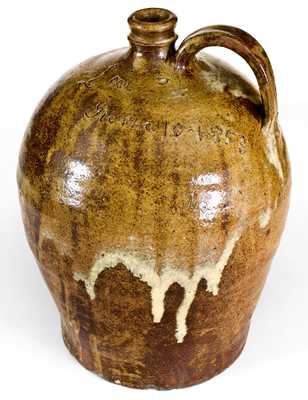
Exceptional Stoneware Jug by Dave, Inscribed "Lm / June 10 1853," Edgefield District, SC
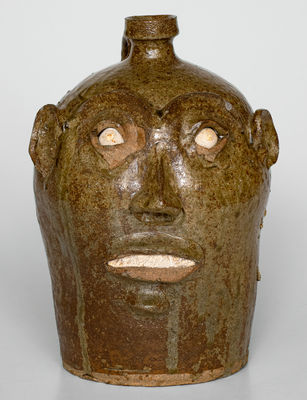
Exceedingly Rare and Important Alkaline-Glazed Stoneware Face Jug, Edgefield District, SC, c1850-1880
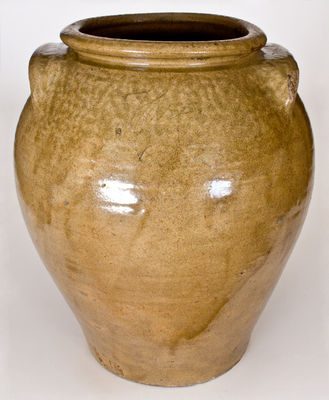
Extremely Important Jar by Enslaved Potter Harry, Pottersville, Edgefield District, SC, circa 1840